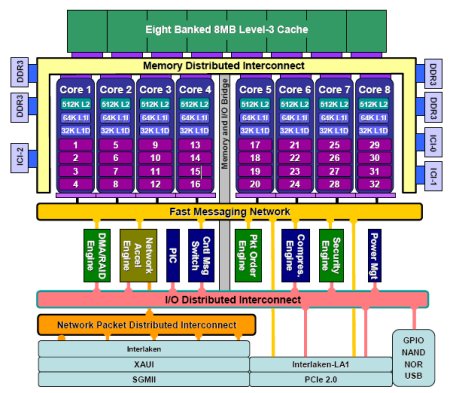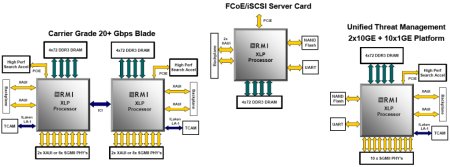Multi-core SoCs go superscalar
May 20, 2009 — by Eric Brown — from the LinuxDevices Archive — 17 viewsRMI Corp. unveiled a superscalar, 40nm-fabricated addition to its family of multi-core MIPS64-based system-on-chips (SoCs) that can support both data- and control-plane processing. The first member of the Linux-compatible XLP family is the XLP832, which can mix eight “EC4400” cores clocked at 500MHz to over 2GHz, the chipmaker says.
The XLP832 SoC is aimed at wired and wireless security, networking, storage, data center acceleration, load balancing, and other acceleration engines, says RMI. Core frequencies are said to range from 500MHz to greater than 2GHz, but with a corresponding higher power draw.
According to RMI (formerly Raza Microelectronics Inc.), XLP732 offers three times the performance per Watt of its previous XLR SoCs, which were introduced in 2005. The XLR also integrated four or eight MIPS64 cores, but each was clocked at only 1.5GHz. More importantly, the XLR cores lacked the XLP's superscalar operation and 40nm fabrication.
As with the XLR, each of the XLP's EC4400 cores offers fine-grained multi-threading capability for fast, throughput-oriented data plane processing, says RMI. However, the XLP also provides a superscalar engine with out-of-order execution capabilities capable of handling high-performance control plane processing. By combining quad-issue instruction scheduling and simultaneous four-way multi-threading within each core, the XLP can support high-performance data plane and control plane operation within a single chip, says the company.

XLP832 block diagram
(Click to enlarge)
Superscalar technology is also found in the rival Octeon II family of multi-core SoCs from Cavium, which, like the XLP, is aimed primarily at networking, telecom, and storage applications. Offering up to 32 cores, the Octeon II is also claimed to support both data- and control-plane processing. In addition, superscalar technology has been introduced to the broader single-core embedded market with ARM's Cortex-A8 core, which drives the Texas Instruments OMAP3x platform, as well as Freescale's new i.MX51 family of SoCs.
MontaVista first up with Linux support
The XLP832 is said to be software backward-compatible with the Linux-ready XLR and XLS families. MontaVista Software announced this week that its MontaVista Linux platform, which offers Carrier Grade Linux (CGL) 4.0 support, will support the XLP. Although RMI did not detail development support plans for the XLP, previous XLR and XLS chips have been backed up with Linux-compatible evaluation boards and software development kits (SDKs). In April 2008, Wind River ported its CGL 4.0-compliant Wind River Linux distribution to the XLR family.

Application examples for the XLP832
(Click to enlarge)
Specific features and benefits of the XLP832 SoC are said to include:
- EC440 cores — Combining superscalar, quad-issue instruction scheduling and simultaneous four-way multi-threading, the EC440 cores are said to be compliant with MIPS64 Release-II and contain IEEE754 and MIPS-compliant floating point units. Each of the four threads, dubbed “VirtuCores,” appear to software as separate processing elements, resulting in more flexible software architectures that are easier to work with, claims the company.
- MOESI+ cache architecture — With the XLP832's “MOESI+” coherent, three-level cache architecture, each of the eight EC4400 cores is said to contain a dedicated 64KB instruction cache, a 32-KB L1 data cache, and a 512KB, 8-way set-associative L2 cache. In addition, each core shares access to an 8-bank, 16-way set-associative 8MB L3 cache, adding up to a claimed total of 12MB of cached data per SoC.
- Memory subsystem — The memory subsystem offers four on-chip, 72-bit DDR3 controllers with 51.2GBps (gigabytes per second) of bandwidth, claims RMI.
- Fast Messaging Network (FMN) — The low-latency FMN enables non-intrusive communication and control messaging among VirtuCores, acceleration engines, and I/O — and without the need for spin-locks or semaphores, claims the company. The FMN can pass control descriptors, enabling lockless simultaneous access to peripheral devices, thereby simplifying and increasing the performance of device drivers, says the company.
- Acceleration engines — The XLP832 incorporates autonomous acceleration engines that offload processing tasks from the cores, including:
- Network acceleration engine supporting up to a claimed 40Gbps of packet throughput, and offering:
- Programmable packet parsing engine
- FCoE, iSCSI, and SCTP checksum/CRC generation and verification
- TCP/UDP/IP checksum on both ingress and egress
- TCP segmentation offload
- IEEE1588v2 precision timing protocol support
- Packet Ordering Engine (POE) for packet ordering of up to 64K flows, capable of up to 60 million packets per second, or the equivalent of 40Gbps with 64-byte packets
- Security acceleration engine with 40Gbps bandwidth
- Compression/decompression engine with 10Gbps bandwidth
- 8-channel DMA and storage acceleration engine, supporting RAID-5 XOR and de-duplication acceleration, as well as RAID-6 P+Q Galois computations
- Network acceleration engine supporting up to a claimed 40Gbps of packet throughput, and offering:
- Interfaces — The SoC contains a variety of networking and peripherals interfaces, including:
- 4 x PCIe 2.0 controllers
- Interlaken
- LA-1 Interlaken for TCAM
- XAUI
- SGMI
- 2 x USB 2.0 ports (Host and Client)
- PCMCIA interface
- NAND and NOR flash memory interfaces
- 2 x I2C interfaces
- 2 x 16550 UART interfaces
- GPIO interfaces
Background
In addition to the new XLP and earlier XLR procesors, RMI also offers a lower powered, more affordable XLS family, which includes the year-old XLS208, as well as the older XLS 600 and 400 series. The XLS devices are designed primarily for integrated security, access point, router, and switch devices, says RMI.
RMI also sells the MIPS-based, Alchemy-architecture Au1250 SoC clocked from 400MHz to 600MHz, which is targeted at consumer electronics and other embedded devices. Last month Embedded Alley announced a version of the Google-backed Android stack for the Au1250, targeting devices ranging from set-top boxes (STBs) to industrial equipment.
Stated Patrick MacCartee, Director of Product Management, MontaVista Software, “MontaVista is pleased to be part of RMI's announcement of the XLP Processor family. The combination of our commercial grade open source Linux that offers real-time performance and RMI's multi-threading capabilities brings a truly customizable platform for the next generation of intelligent networking systems.”
Stated Behrooz Abdi, president and CEO, RMI, “The XLP Processor is a significant milestone for RMI on the way to becoming the leading communication processor company in the industry. The combination of our high performance architecture and advanced 40nm technology will put us significantly ahead of the competition.”
Availability
RMI did not offer pricing or availability information on the new XLP832 SoC. More information may be found here. The company will be demonstrating the XLP processor today and tomorrow at the Interop show in Las Vegas at the Mandalay Bay Convention Center, booth #2412.
This article was originally published on LinuxDevices.com and has been donated to the open source community by QuinStreet Inc. Please visit LinuxToday.com for up-to-date news and articles about Linux and open source.